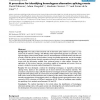Free Online Productivity Tools
i2Speak
i2Symbol
i2OCR
iTex2Img
iWeb2Print
iWeb2Shot
i2Type
iPdf2Split
iPdf2Merge
i2Bopomofo
i2Arabic
i2Style
i2Image
i2PDF
iLatex2Rtf
Sci2ools
BMCBI
2007
2007
A procedure for identifying homologous alternative splicing events
Background: The study of the functional role of alternative splice isoforms of a gene is a very active area of research in biology. The difficulty of the experimental approach (in particular, in its high-throughput version) leaves ample room for the development of bioinformatics tools that can provide a useful first picture of the problem. Among the possible approaches, one of the simplest is to follow classical protein function annotation protocols and annotate target alternative splice events with the information available from conserved events in other species. However, the application of this protocol requires a procedure capable of recognising such events. Here we present a simple but accurate method developed for this purpose. Results: We have developed a method for identifying homologous, or equivalent, alternative splicing events, based on the combined use of neural networks and sequence searches. The procedure comprises four steps: (i) BLAST search for homologues of the two i...
| Added | 08 Dec 2010 |
| Updated | 08 Dec 2010 |
| Type | Journal |
| Year | 2007 |
| Where | BMCBI |
| Authors | David Talavera, Adam Hospital, Modesto Orozco, Xavier de la Cruz |
Comments (0)

